Advertisements
Online Mock Tests
Chapters
▶ 2: Solutions
3: Electrochemistry
4: Chemical Kinetics
5: Surface Chemistry
6: General Principle and Processes of Isolation of Elements
7: The p-block Elements
8: The d-and f-Block Elements
9: Coordination Compounds
10: Haloalkanes and Haloarenes
11: Alcohols, Phenols and Ethers
12: Aldehydes, Ketones and Carboxylic Acids
13: Amines
14: Biomolecules
15: Polymers
16: Chemistry In Everyday Life
![NCERT Exemplar solutions for Chemistry [English] Class 12 chapter 2 - Solutions NCERT Exemplar solutions for Chemistry [English] Class 12 chapter 2 - Solutions - Shaalaa.com](/images/chemistry-english-class-12_6:5f2b1b2038084cf381bfa42c826a928c.jpg)
Advertisements
Solutions for Chapter 2: Solutions
Below listed, you can find solutions for Chapter 2 of CBSE NCERT Exemplar for Chemistry [English] Class 12.
NCERT Exemplar solutions for Chemistry [English] Class 12 2 Solutions Exercises [Pages 17 - 28]
Multiple Choice Questions (Type - I)
Which of the following units is useful in relating concentration of solution with its vapour pressure?
Mole fraction
Parts per million
Mass percentage
Molality
On dissolving sugar in water at room temperature solution feels cool to touch. Under which of the following cases dissolution of sugar will be most rapid?
Sugar crystals in cold water.
Sugar crystals in hot water.
Powdered sugar in cold water.
Powdered sugar in hot water.
At equilibrium the rate of dissolution of a solid solute in a volatile liquid solvent is ______.
Less than the rate of crystallisation
Greater than the rate of crystallisation
Equal to the rate of crystallisation
Zero
A beaker contains a solution of the substance ‘A’. Precipitation of substance ‘A’ takes place when a small amount of ‘A’ is added to the solution. The solution is ______.
saturated
supersaturated
unsaturated
concentrated
Maximum amount of a solid solute that can be dissolved in a specified amount of a given liquid solvent does not depend upon ______.
temperature
nature of solute
pressure
nature of solvent
Low concentration of oxygen in the blood and tissues of people living at high altitude is due to ______.
Low temperature
Low atmospheric pressure
High atmospheric pressure
Both low temperature and high atmospheric pressure
Considering the formation, breaking and strength of hydrogen bond, predict which of the following mixtures will show a positive deviation from Raoult’s law?
Methanol and acetone
Chloroform and acetone
Nitric acid and water
Phenol and aniline
Colligative properties depend on ______.
the nature of the solute particles dissolved in solution.
the number of solute particles in solution.
the physical properties of the solute particles dissolved in solution.
the nature of solvent particles.
Which of the following aqueous solutions should have the highest boiling point?
1.0 M NaOH
1.0 M Na2SO4
1.0 M NH4NO3
1.0 M KNO3
The unit of ebulioscopic constant is ______.
K kg mol–1 or K(molality)–1
mol kg K–1 or K–1(molality)
kg mol–1 K–1 or K–1(molality)–1
K mol kg–1 or K(molality)
In comparison to a 0.01 m solution of glucose, the depression in freezing point of a 0.01 m MgCl2 solution is ______.
the same
about twice
about three times
about six times
An unripe mango placed in a concentrated salt solution to prepare pickle, shrivels because ______.
it gains water due to osmosis
it loses water due to reverse osmosis
it gains water due to reverse osmosis
it loses water due to osmosis
At a given temperature, osmotic pressure of a concentrated solution of a substance ______.
is higher than that at a dilute solution.
is lower than that of a dilute solution.
is same as that of a dilute solution.
cannot be compared with osmotic pressure of dilute solution.
Which of the following statements is false?
Two different solutions of sucrose of same molality prepared in different solvents will have the same depression in freezing point.
The osmotic pressure of a solution is given by the equation Π = CRT ( where C is the molarity of the solution).
Decreasing order of osmotic pressure for 0.01 M aqueous solutions of barium chloride, potassium chloride, acetic acid and sucrose is BaCl2 > KCl > CH3COOH > sucrose.
According to Raoult’s law, the vapour pressure exerted by a volatile component of a solution is directly proportional to its mole fraction in the solution.
The values of Van’t Hoff factors for KCl, NaCl and K2SO4, respectively, are ______.
2, 2 and 2
2, 2 and 3
1, 1 and 2
1, 1 and 1
Which of the following statements is false?
Units of atmospheric pressure and osmotic pressure are the same.
In reverse osmosis, solvent molecules move through a semipermeable membrane from a region of lower concentration of solute to a region of higher concentration.
The value of molal depression constant depends on nature of solvent.
Relative lowering of vapour pressure, is a dimensionless quantity.
Value of Henry’s constant KH ______.
increases with increase in temperature.
decreases with increase in temperature.
remains constant.
first increases then decreases.
The value of Henry's constant KH is ______.
greater for gases with higher solubility
greater for gases with lower solubility
constant for all gases
not related to the solubility of gases
Consider the figure and mark the correct option.
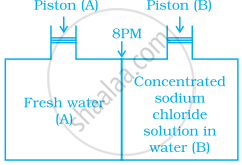
Water will move from side (A) to side (B) if a pressure lower than osmotic pressure is applied on piston (B).
Water will move from side (B) to side (A) if a pressure greater than osmotic, pressure is applied on piston (B).
Water will move from side (B) to side (A) if a pressure equal to osmotic pressure is applied on piston (B).
water will move from side (A) to side (B) if pressure equal to osmotic pressure is applied on piston (A).
We have three aqueous solutions of NaCl labelled as ‘A’, ‘B’ and ‘C’ with concentrations 0.1 M, 0.01 M and 0.001 M, respectively. The value of van’t Hoff factor for these solutions will be in the order ______.
iA < iB < iC
iA > iB > iC
iA = iB = iC
iA < iB > iC
On the basis of information given below mark the correct option.
(A) In bromoethane and chloroethane mixture intermolecular interactions of A–A and B–B type are nearly same as A–B type interactions.
(B) In ethanol and acetone mixture A–A or B–B type intermolecular interactions are stronger than A–B type interactions.
(C) In chloroform and acetone mixture A–A or B–B type intermolecular interactions are weaker than A–B type interactions.
Solution (B) and (C) will follow Raoult’s law.
Solution (A) will follow Raoult’s law.
Solution (B) will show negative deviation from Raoult’s law.
Solution (C) will show positive deviation from Raoult’s law.
Two beakers of capacity 500 mL were taken. One of these beakers, labelled as “A”, was filled with 400 mL water whereas the beaker labelled “B” was filled with 400 mL of 2 M solution of NaCl. At the same temperature both the beakers were placed in closed containers of same material and same capacity as shown in figure.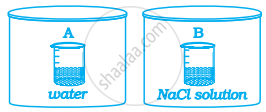
At a given temperature, which of the following statement is correct about the vapour pressure of pure water and that of NaCl solution.
Vapour pressure in container (A) is more than that in container (B).
Vapour pressure in container (A) is less than that in container (B).
Vapour pressure is equal in both the containers.
Vapour pressure in container (B) is twice the vapour pressure in container (A).
If two liquids A and B form minimum boiling azeotrope at some specific composition then ______.
A–B interactions are stronger than those between A–A or B–B.
vapour pressure of solution increases because more number of molecules of liquids A and B can escape from the solution.
vapour pressure of solution decreases because less number of molecules of only one of the liquids escape from the solution.
A–B interactions are weaker than those between A–A or B–B.
4 L of 0.02 M aqueous solution of NaCl was diluted by adding one litre of water. The molality of the resultant solution is ______.
0.004
0.008
0.012
0.016
On the basis of information given below mark the correct option.
On adding acetone to methanol some of the hydrogen bonds between methanol molecules break.
At specific composition methanol-acetone mixture will form minimum boiling azeotrope and will show positive deviation from Raoult’s law.
At specific composition methanol-acetone mixture forms maximum boiling azeotrope and will show positive deviation from Raoult’s law.
At specific composition methanol-acetone mixture will form minimum boiling azeotrope and will show negative deviation from Raoult’s law.
At specific composition methanol-acetone mixture will form maximum boiling azeotrope and will show negative deviation from Raoult’s law.
KH value for \[\ce{Ar(g)}\], \[\ce{CO2(g)}\], \[\ce{HCHO (g)}\] and \[\ce{CH4(g)}\] are 40.39, 1.67, 1.83 × 10–5 and 0.413 respectively. Arrange these gases in the order of their increasing solubility.
\[\ce{HCHO < CH4 < CO2 < Ar}\]
\[\ce{HCHO < CO2 < CH4 < Ar}\]
\[\ce{Ar < CO2 < CH4 < HCHO}\]
\[\ce{Ar < CH4 < CO2 < HCHO}\]
Multiple Choice Questions (Type-II) Note: In the following questions two or more options may be correct.
Which of the following factor(s) affect the solubility of a gaseous solute in the fixed volume of liquid solvent?
(a) nature of solute
(b) temperature
(c) pressure
(i) (a) and (c) at constant T
(ii) (a) and (b) at constant P
(iii) (b) and (c) only
(iv) (c) only
Intermolecular forces between two benzene molecules are nearly of same strength as those between two toluene molecules. For a mixture of benzene and toluene, which of the following are not true?
(i) ∆mix H = zero
(ii) ∆mix V = zero
(iii) These will form minimum boiling azeotrope.
(iv) These will not form ideal solution.
Relative lowering of vapour pressure is a colligative property because:
(i) It depends on the concentration of a non electrolyte solute in solution and does not depend on the nature of the solute molecules.
(ii) It depends on number of particles of electrolyte solute in solution and does not depend on the nature of the solute particles.
(iii) It depends on the concentration of a non electrolyte solute in solution as well as on the nature of the solute molecules.
(iv) It depends on the concentration of an electrolyte or nonelectrolyte solute in solution as well as on the nature of solute molecules.
Van’t Hoff factor i is given by the expression:
(i) i = `"Normal molar mass"/"Abnormal molar mass"`
(ii) i = `"Abnormal molar mass"/"Normal molar mass"`
(iii) i = `"Observed colligative property"/"Calculated colligative property"`
(iv) i = `"Calculated colligative property"/"Observed colligative property"`
Isotonic solutions must have the same:
(i) solute
(ii) density
(iii) elevation in boiling point
(iv) depression in freezing point
Which of the following binary mixtures will have same composition in liquid and vapour phase?
(i) Benzene - Toluene
(ii) Water-Nitric acid
(iii) Water-Ethano
(iv) n-Hexane - n-Heptane
In isotonic solutions:
(i) Solute and solvent both are same.
(ii) Osmotic pressure is same.
(iii) Solute and solvent may or may not be same.
(iv) Solute is always same solvent may be different.
For a binary ideal liquid solution, the variation in total vapour pressure versus composition of solution is given by which of the curves?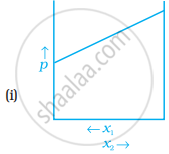
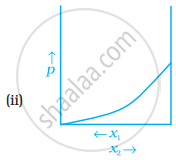

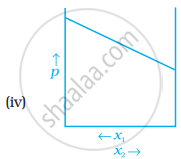
Colligative properties are observed when:
(i) a non volatile solid is dissolved in a volatile liquid.
(ii) a non volatile liquid is dissolved in another volatile liquid.
(iii) a gas is dissolved in non volatile liquid.
(iv) a volatile liquid is dissolved in another volatile liquid.
Components of a binary mixture of two liquids A and B were being separated by distillation. After some time separation of components stopped and composition of vapour phase became same as that of liquid phase. Both the components started coming in the distillate. Explain why this happened.
Explain why on addition of 1 mol of NaCl to 1 litre of water, the boiling point of water increases, while addition of 1 mol of methyl alcohol to one litre of water decreases its boiling point.
Explain the solubility rule “like dissolves like” in terms of intermolecular forces that exist in solutions.
Concentration terms such as mass percentage, ppm, mole fraction and molality are independent of temperature, however molarity is a function of temperature. Explain.
What is the significance of Henry’s Law constant KH?
Why are aquatic species more comfortable in cold water in comparison to warm water?
Explain the following phenomena with the help of Henry’s law.
Painful condition known as bends.
Explain the following phenomena with the help of Henry’s law.
Feeling of weakness and discomfort in breathing at high altitude.
Why soda water bottle kept at room temperature fizzes on opening?
Why is the vapour pressure of an aqueous solution of glucose lower than that of water?
How does sprinkling of salt help in clearing the snow covered roads in hilly areas? Explain the phenomenon involved in the process.
What is “semi permeable membrane”?
Give an example of a material used for making semipermeable membrane for carrying out reverse osmosis.
Matching Type Note: In the following questions match the items given in Column I and Column II.
Match the items given in Column I and Column II.
| Column I | Column II |
| (i) Saturated solution | (a) Solution having same osmotic pressure at a given temperature as that of given solution. |
| (ii) Binary solution | (b) A solution whose osmotic pressure is less than that of another. |
| (iii) Isotonic solution | (c) Solution with two components. |
| (iv) Hypotonic solution | (d) A solution which contains maximum amount of solute that can be dissolved in a given amount of solvent at a given temperature. |
| (v) Solid solution | (e) A solution whose osmotic pressure is more than that of another. |
| (vi) Hypertonic solution | (f) A solution in solid phase. |
Match the items given in Column I with the type of solutions given in Column II.
| Column I | Column II |
| (i) Soda water | (a) A solution of gas in solid |
| (ii) Sugar solution | (b) A solution of gas in gas |
| (iii) German silver | (c) A solution of solid in liquid |
| (iv) Air | (d) A solution of solid in solid |
| (v) Hydrogen gas in palladium | (e) A solution of gas in liquid |
| (f) A solution of liquid in solid |
Match the laws given in Column I with expresions given in Column II.
| Column I | Column II |
| (i) Raoult's law | (a) `ΔT_f = K_fm` |
| (ii) Henry's law | (b) π = CRT |
| (iii) Elevation of boiling point | (c) `p = x_1p_1^0 + x_2p_2^0` |
| (iv) Depression in freezing point | (d) `ΔT_b = K_bm` |
| (v) Osmotic pressure | (e) `p = K_H.x` |
Match the terms given in Column I with expressions given in Column II.
| Column I | Column II |
| (i) Mass percentage | (a) `"Number of moles of the solute component"/"Volume of solution in litres"` |
| (ii) Volume percentage | (b) `"Number of moles of a component"/"Total number of moles of all the components"` |
| (iii) Mole fraction | (c) `"Volume of the solute component in solution"/"Total volume of solution" xx 100` |
| (iv) Molality | (d) `"Mass of the solute component in solution"/"Total mass of the solution" xx 100` |
| (v) Molarity | (e) `"Number of moles of the solute components"/"Mass of solvent in kilograms"` |
Assertion and Reason Type Note: In the following questions a statement of assertion followed by a statement of reason is given. Choose the correct answer out of the following choices.
Assertion: Molarity of a solution in liquid state changes with temperature.
Reason: The volume of a solution changes with change in temperature.
Assertion and reason both are correct statements and reason is correct explanation for assertion.
Assertion and reason both are correct statements but reason is not correct explanation for assertion.
Assertion is correct statement but reason is wrong statement.
Assertion and reason both are incorrect statements.
Assertion is wrong statement but reason is correct statement.
Assertion: When methyl alcohol is added to water, the boiling point of water increases.
Reason: When a volatile solute is added to a volatile solvent elevation in boiling point is observed.
Assertion and reason both are correct statements and reason is the correct explanation for assertion.
Assertion and reason both are correct statements but the reason is not the correct explanation for assertion.
Assertion is a correct statement but the reason is the wrong statement.
Assertion and reason both are incorrect statements.
Assertion is a wrong statement but the reason is the correct statement.
Assertion: When NaCl is added to water a depression in freezing point is observed.
Reason: The lowering of vapour pressure of a solution causes depression in the freezing point.
Assertion and reason both are correct statements and reason is correct explanation for assertion.
Assertion and reason both are correct statements but reason is not correct explanation for assertion.
Assertion is correct statement but reason is wrong statement.
Assertion and reason both are incorrect statements.
Assertion is wrong statement but reason is correct statement.
Assertion: When a solution is separated from the pure solvent by a semipermeable membrane, the solvent molecules pass through it from pure solvent side to the solution side.
Reason: Diffusion of solvent occurs from a region of high concentration solution to a region of low concentration solution.
Assertion and reason both are correct statements and reason is correct explanation for assertion.
Assertion and reason both are correct statements but reason is not correct explanation for assertion.
Assertion is correct statement but reason is wrong statement.
Assertion and reason both are incorrect statements.
Assertion is wrong statement but reason is correct statement.
Define the following modes of expressing the concentration of a solution. Which of these modes are independent of temperature and why?
w/w (mass percentage)
Define the following modes of expressing the concentration of a solution. Which of these modes are independent of temperature and why?
V/V (volume percentage)
Define the following modes of expressing the concentration of a solution. Which of these modes are independent of temperature and why?
(iii) w/V (mass by volume percentage)
Define the following modes of expressing the concentration of a solution. Which of these modes are independent of temperature and why?
ppm. (parts per million)
Define the following modes of expressing the concentration of a solution. Which of these modes are independent of temperature and why?
x (mole fraction)
Define the following modes of expressing the concentration of a solution. Which of these modes are independent of temperature and why?
M (Molarity)
Define the following modes of expressing the concentration of a solution. Which of these modes are independent of temperature and why?
m (Molality)
Using Raoult’s law explain how the total vapour pressure over the solution is related to mole fraction of components in the following solutions.
\[\ce{CHCl3(l) and CH2Cl2(l)}\]
Using Raoult’s law explain how the total vapour pressure over the solution is related to mole fraction of components in the following solutions.
\[\ce{NaCl(s) and H2O(l)}\]
Explain the terms ideal and non-ideal solutions in the light of forces of interactions operating between molecules in liquid solutions.
Why is it not possible to obtain pure ethanol by fractional distillation? What general name is given to binary mixtures which show deviation from Raoult’s law and whose components cannot be separated by fractional distillation. How many types of such mixtures are there?
When kept in water, raisin swells in size. Name and explain the phenomenon involved with the help of a diagram. Give three applications of the phenomenon.
Discuss biological and industrial importance of osmosis.
How can you remove the hard calcium carbonate layer of the egg without damaging its semiprermiable membrane? Can this egg be inserted into a bottle with a narrow neck without distorting its shape? Explain the process involved.
Why is the mass determined by measuring a colligative property in case of some solutes abnormal ? Discuss it with the help of Van’t Hoff factor.
Solutions for 2: Solutions
![NCERT Exemplar solutions for Chemistry [English] Class 12 chapter 2 - Solutions NCERT Exemplar solutions for Chemistry [English] Class 12 chapter 2 - Solutions - Shaalaa.com](/images/chemistry-english-class-12_6:5f2b1b2038084cf381bfa42c826a928c.jpg)
NCERT Exemplar solutions for Chemistry [English] Class 12 chapter 2 - Solutions
Shaalaa.com has the CBSE Mathematics Chemistry [English] Class 12 CBSE solutions in a manner that help students grasp basic concepts better and faster. The detailed, step-by-step solutions will help you understand the concepts better and clarify any confusion. NCERT Exemplar solutions for Mathematics Chemistry [English] Class 12 CBSE 2 (Solutions) include all questions with answers and detailed explanations. This will clear students' doubts about questions and improve their application skills while preparing for board exams.
Further, we at Shaalaa.com provide such solutions so students can prepare for written exams. NCERT Exemplar textbook solutions can be a core help for self-study and provide excellent self-help guidance for students.
Concepts covered in Chemistry [English] Class 12 chapter 2 Solutions are Types of Solutions, Expressing Concentration of Solutions, Solubility of a Gas in a Liquid, Solubility of a Solid in a Liquid, Colligative Properties and Determination of Molar Mass - Introduction, Relative Lowering of Vapour Pressure, Vapour Pressure of Liquid- Liquid Solutions, Elevation of Boiling Point, Introduction of Solubility, Vapour Pressure of Liquid Solutions - Introduction, Raoult’s Law as a Special Case of Henry’s Law, Vapour Pressure of Solutions of Solids in Liquids, Ideal and Non-ideal Solutions, Solution Numericals, Quantitative Concentration Numericals, Composition of Vapour Phase, Kohlrausch's law, Introduction of Solution, Depression of Freezing Point, Osmosis and Osmotic Pressure, Reverse Osmosis and Water Purification, Abnormal Molar Masses.
Using NCERT Exemplar Chemistry [English] Class 12 solutions Solutions exercise by students is an easy way to prepare for the exams, as they involve solutions arranged chapter-wise and also page-wise. The questions involved in NCERT Exemplar Solutions are essential questions that can be asked in the final exam. Maximum CBSE Chemistry [English] Class 12 students prefer NCERT Exemplar Textbook Solutions to score more in exams.
Get the free view of Chapter 2, Solutions Chemistry [English] Class 12 additional questions for Mathematics Chemistry [English] Class 12 CBSE, and you can use Shaalaa.com to keep it handy for your exam preparation.
